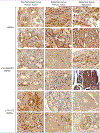Ser-486/491 phosphorylation and inhibition of AMPKα activity is positively associated with Gleason score, metastasis, and castration-resistance in prostate cancer: A retrospective clinical study
- PMID: 29577356
- PMCID: PMC6591712
- DOI: 10.1002/pros.23515
Ser-486/491 phosphorylation and inhibition of AMPKα activity is positively associated with Gleason score, metastasis, and castration-resistance in prostate cancer: A retrospective clinical study
Abstract
Background: We previously demonstrated that adenosine monophosphate-activated protein kinase (AMPKα) activity is significantly inhibited by Ser-486/491 phosphorylation in cell culture and in vivo models of metastatic and castration-resistant prostate cancer, and hypothesized these findings may translate to clinical specimens.
Methods: In this retrospective, single-institution pilot study, 45 metastatic prostate cancer cases were identified within the University Hospitals Cleveland Medical Center Pathology Archive with both metastasis and matched primary prostate tumor specimens in formalin-fixed, paraffin-embedded blocks, and complete electronic medical records. Thirty non-metastatic, hormone-dependent prostate cancer controls, who were progression-free as defined by undetectable prostate specific antigen for at least 79.6 months (range 79.6-136.0 months), and matched metastatic cases based on age, race, and year of diagnosis. All specimens were collected from 1991 to 2014; primary tumor specimens were obtained via diagnostic biopsy or prostatectomy, and metastasis specimens obtained via surgery or perimortem. 5-μ sequential slides were processed for phospho-Ser-486/491 AMPKα1 /α2 , phospho-Thr-172 AMPKα, AMPKα1 /α2 , phospho-Ser-792 Raptor, phospho-Ser-79 acetyl-CoA carboxylase, and phospho-Ser-872, 3-hydroxy-3-methylglutaryl-CoA reductase immunohistochemistry to determine expression, phosphorylation pattern, and activity of AMPKα.
Results: Increased inhibitory Ser-486/491 AMPKα1 /α2 phosphorylation, increased AMPKα protein expression, decreased AMPKα activity, and loss of nuclear AMPKα and p-AMPKα are associated with prostate cancer progression to metastasis. Increased p-Ser-486/491 AMPKα1 /α2 was also positively correlated with higher Gleason grade and progression to castration-resistance.
Conclusions: p-Ser-486/491 AMPKα1 /α2 is a novel marker of prostate cancer metastasis and castration-resistance. Ser-486/491 phosphokinases should be pursued as targets for metastatic and castration-resistant prostate cancer chemotherapy.
Keywords: pathology; AMP-activated protein kinase; castration-resistant prostate cancer; clinical specimens; metastasis; prostatic neoplasms.
© 2018 Wiley Periodicals, Inc.
Conflict of interest statement
Figures


Similar articles
-
Synergistic simvastatin and metformin combination chemotherapy for osseous metastatic castration-resistant prostate cancer.Mol Cancer Ther. 2014 Oct;13(10):2288-302. doi: 10.1158/1535-7163.MCT-14-0451. Epub 2014 Aug 13. Mol Cancer Ther. 2014. PMID: 25122066 Free PMC article.
-
SIRT1, AMP-activated protein kinase phosphorylation and downstream kinases in response to a single bout of sprint exercise: influence of glucose ingestion.Eur J Appl Physiol. 2010 Jul;109(4):731-43. doi: 10.1007/s00421-010-1413-y. Epub 2010 Mar 9. Eur J Appl Physiol. 2010. PMID: 20217115 Clinical Trial.
-
Prostate-specific antigen level, stage or Gleason score: which is best for predicting outcomes after radical prostatectomy, and does it vary by the outcome being measured? Results from Shared Equal Access Regional Cancer Hospital database.Int J Urol. 2015 Apr;22(4):362-6. doi: 10.1111/iju.12704. Epub 2015 Feb 24. Int J Urol. 2015. PMID: 25728968
-
Critical role for free radicals on sprint exercise-induced CaMKII and AMPKα phosphorylation in human skeletal muscle.J Appl Physiol (1985). 2013 Mar 1;114(5):566-77. doi: 10.1152/japplphysiol.01246.2012. Epub 2013 Jan 3. J Appl Physiol (1985). 2013. PMID: 23288553
-
Clinicopathologic Diagnostic Approach to Aggressive Variant Prostate Cancer.Arch Pathol Lab Med. 2020 Jan;144(1):18-23. doi: 10.5858/arpa.2019-0124-RA. Epub 2019 Aug 12. Arch Pathol Lab Med. 2020. PMID: 31403335 Review.
Cited by
-
Emerging proteins involved in castration‑resistant prostate cancer via the AR‑dependent and AR‑independent pathways (Review).Int J Oncol. 2023 Nov;63(5):127. doi: 10.3892/ijo.2023.5575. Epub 2023 Sep 21. Int J Oncol. 2023. PMID: 37732538 Free PMC article. Review.
References
-
- Hurley RL, Barré LK, Wood SD, Anderson KA, Kemp BE, Means AR, Witters LA. Regulation of AMP-activated protein kinase by multisite phosphorylation in response to agents that elevate cellular cAMP. J Biol Chem 2006;281:36662–36672. - PubMed
Publication types
MeSH terms
Substances
Grants and funding
LinkOut - more resources
Full Text Sources
Other Literature Sources
Research Materials

